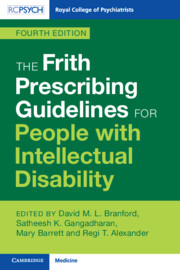Book contents
- The Frith Prescribing Guidelines for People with Intellectual Disability
- Reviews
- The Frith Prescribing Guidelines for People with Intellectual Disability
- Copyright page
- Contents
- Contributors
- Foreword
- Preface
- Acknowledgements
- Chapter 1 Intellectual Disability
- Chapter 2 Prescribing Practice
- Chapter 3 Physical Health Monitoring
- Chapter 4 Mental Health Conditions in People with Intellectual Disability
- Chapter 5 Trauma in People with Intellectual Disability
- Chapter 6 Anxiety Disorders
- Chapter 7 Depression
- Chapter 8 Bipolar Disorders
- Chapter 9 Schizophrenia
- Chapter 10 Aggression and Self-Injurious Behaviour
- Chapter 11 Personality Disorders
- Chapter 12 Sexual Offences and Paraphilias
- Chapter 13 Substance Use Disorders
- Chapter 14 Attention Deficit Hyperactivity Disorder
- Chapter 15 Autism
- Chapter 16 Sleep Disorders
- Chapter 17 Epilepsy
- Chapter 18 Dementia
- Chapter 19 Eating and Drinking Difficulties
- Chapter 20 Children and Adolescents
- Chapter 21 Prescribing for Health Issues in Women with Intellectual Disability
- Chapter 22 Older People
- Index
- References
Chapter 8 - Bipolar Disorders
Published online by Cambridge University Press: 07 November 2024
- The Frith Prescribing Guidelines for People with Intellectual Disability
- Reviews
- The Frith Prescribing Guidelines for People with Intellectual Disability
- Copyright page
- Contents
- Contributors
- Foreword
- Preface
- Acknowledgements
- Chapter 1 Intellectual Disability
- Chapter 2 Prescribing Practice
- Chapter 3 Physical Health Monitoring
- Chapter 4 Mental Health Conditions in People with Intellectual Disability
- Chapter 5 Trauma in People with Intellectual Disability
- Chapter 6 Anxiety Disorders
- Chapter 7 Depression
- Chapter 8 Bipolar Disorders
- Chapter 9 Schizophrenia
- Chapter 10 Aggression and Self-Injurious Behaviour
- Chapter 11 Personality Disorders
- Chapter 12 Sexual Offences and Paraphilias
- Chapter 13 Substance Use Disorders
- Chapter 14 Attention Deficit Hyperactivity Disorder
- Chapter 15 Autism
- Chapter 16 Sleep Disorders
- Chapter 17 Epilepsy
- Chapter 18 Dementia
- Chapter 19 Eating and Drinking Difficulties
- Chapter 20 Children and Adolescents
- Chapter 21 Prescribing for Health Issues in Women with Intellectual Disability
- Chapter 22 Older People
- Index
- References
Summary
Bipolar disorders are episodic mood disorders defined by the occurrence of manic, mixed, or hypomanic episodes or symptoms. Manic and hypomanic symptoms are characterised by a subjective experience of increased energy and activity, along with various other symptoms. These episodes typically alternate over the course of these disorders with depressive episodes or periods of depressive symptoms such as lowering of mood, decreased energy and activity (ICD-11, 2019; DSM-5, 2013). Both the American Psychiatric Association’s Diagnostic and Statistical Manual of Mental Disorders DSM-5 and the International Classification of Diseases ICD-11 broadly subclassify the condition as follows: bipolar I disorder: one or more manic episodes or mixed episodes. Individuals often have one or more major depressive episodes; bipolar II disorder: one or more major depressive episodes accompanied by at least one hypomanic episode. Bipolar affective disorders present a major diagnostic and treatment challenge to services for people with intellectual disability. The chapter presents an overview of the condition, the treatments with medication available, and their relevance. The chapter includes the use of mood stabilisers such as sodium valproate.
- Type
- Chapter
- Information
- Publisher: Cambridge University PressPrint publication year: 2024

